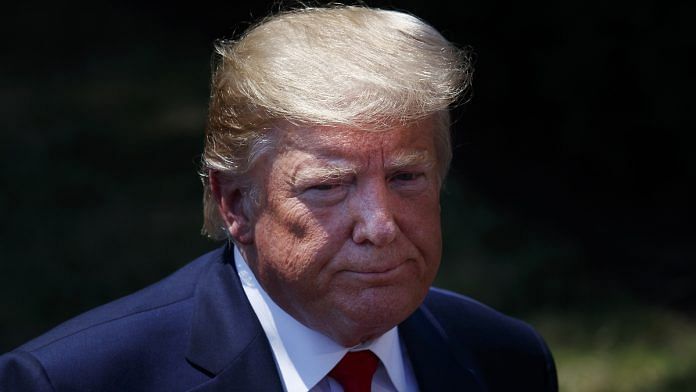New Delhi: Articles of impeachment will be drawn against US President Donald Trump for alleged abuse of power, announced Democratic Party leader Nancy Pelosi Thursday.
The Speaker of House of Representatives (lower house), Pelosi said, “The president abused his power for his own political benefit at the expense of our national security, by withholding military aid and a crucial Oval Office (at the White House) meeting in exchange for an announcement for an investigation into his political rival (Joe Biden).”
This announcement starts the next phase of the impeachment proceedings against Trump. The House Judiciary Committee had in the last week of November held its first public impeachment hearing against the president.
ThePrint takes a look at the charges against Trump, the impeachment proceedings and what is likely to take place next.
Also read: Whistleblower, Bidens, Pelosi, Bolton — here’s the cast in Trump impeachment proceedings
What has happened until now
An impeachment proceeding in the US starts in the House of Representatives and the decision to begin one lies with the speaker. The House Judiciary Committee is then instructed to investigate the matter. In case the issue pertains to any other House committee, they are also asked to join in the investigation.
Pelosi had launched the impeachment proceedings against Trump on 24 September. She had instructed the House Judiciary and five other committees to investigate the Trump-Ukraine affair. There are allegations that the president had improperly sought help from Ukraine to boost his chances of re-election.
The other committees included in the investigation include the Intelligence, Foreign Affairs, Oversight & Reform, Financial Services, and Ways & Means. This impeachment probe requires congressional testimonies by various witnesses.
Following the September announcement, a list of characters involved in the Trump-Ukraine saga had given closed-door testimonies to the above mentioned House committees.
But Trump’s Republican Party had complained that the impeachment inquiry carried out by the House Democrats lacked transparency and a resolution was passed. From that point on, closed-door testimonies made way for televised public hearings.
“On Wednesday, three constitutional law experts testified to the House Judiciary Committee that Mr Trump’s actions to obtain help from a foreign nation amounted to an impeachable offence,” notes a report in the BBC.
Another professor, who was testifying had said that Trump’s actions were “wrong” but “not impeachable”.
During her recent impeachment announcement, Pelosi also said that all testimonies conducted until now show that facts against Trump are “uncontested”.
The impeachment articles
Once the House committees conclude their investigations, impeachment articles are drawn against the president. These articles essentially contain the ‘impeachable’ charges against the president.
“The six chairs of the committees investigating Trump, including Judiciary Chairman Jerry Nadler, are expected to huddle privately after Pelosi’s announcement,” reported Politico.
These six chairs are expected to draw the articles of impeachment over the next few days.
While Pelosi did not state the exact content of the forthcoming piece of impeachment, according to Politico, the Democrats are “considering multiple articles…against Trump including abuse of power, obstruction of justice and obstruction of Congress”.
Also read: US President Trump says ‘sham’ impeachment proceedings shouldn’t be allowed
What happens next?
The impeachment procedure states that once the articles are drawn, the House Judiciary Committee will first vote on them. A simple majority vote (51 per cent) is required for the impeachment process to proceed.
After that, the entire House of Representatives (lower house) votes on the impeachment articles. If the articles manage to receive a simple majority, the president will technically be impeached.
Once a president has been impeached by the House, an impeachment trial is held at the Senate (upper house). And after the trial, a two-thirds majority is required to convict and remove the president.
So, even after being impeached by the House, if the Senate does not convict the president he continues to remain in office.
The Democrats at present have a majority in both the House Judiciary Committee and the House of Representatives. The House currently consists of 235 Democrats, 198 Republicans, one Independent and a vacant seat. Meanwhile, the Senate has 53 Republicans, 45 Democrats, and two Independents.
So it is expected that Trump will be impeached by the House of Representatives but not by the Senate — where the Democrats are in minority.
According to reports, the House of Representatives is expected to vote on the impeachment articles before the end of this year and the trial at the Senate could begin by January 2020.
Responding to these developments, Trump had take to Twitter to say: “If you are going to impeach me, do it now, fast, so we can have a fair trial in the Senate, and so that our Country can get back to business.”
(Edited by Myithili Hazarika)
Also read: Who is Michael Bloomberg? 77-yr-old billionaire who just entered 2020 US presidential race




The House of Representatives – later the Senate – is a responsible institution. Impeachment of a President is a solemn task. He should participate / cooperate with the proceedings, seek to clear his name, not rely only on 34 Senators to save his job.